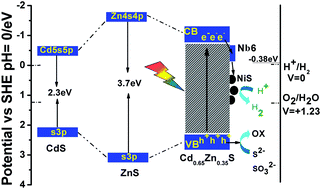Synergetic effect of polyoxoniobate and NiS as cocatalysts for enhanced photocatalytic H2 evolution on Cd0.65Zn0.35S†
Abstract
Composite photocatalyst K7HNb6O19–NiS/Cd0.65Zn0.35S is demonstrated to be highly active for H2 evolution under visible light due to the introduction of K7HNb6O19 and NiS as cocatalysts. In the absence of noble metals, a high quantum yield of 42% was achieved at 420 nm.


 Please wait while we load your content...
Please wait while we load your content...